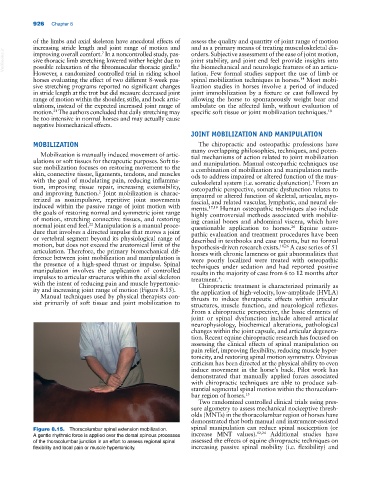Page 960 - Adams and Stashak's Lameness in Horses, 7th Edition
P. 960
926 Chapter 8
of the limbs and axial skeleton have anecdotal effects of assess the quality and quantity of joint range of motion
increasing stride length and joint range of motion and and as a primary means of treating musculoskeletal dis-
VetBooks.ir sive thoracic limb stretching lowered wither height due to joint stability, and joint end feel provide insights into
orders. Subjective assessment of the ease of joint motion,
improving overall comfort. In a noncontrolled study, pas-
7
possible relaxation of the fibromuscular thoracic girdle.
the biomechanical and neurologic features of an articu-
8
However, a randomized controlled trial in riding school lation. Few formal studies support the use of limb or
horses evaluating the effect of two different 8‐week pas- spinal mobilization techniques in horses. Most mobi-
14
sive stretching programs reported no significant changes lization studies in horses involve a period of induced
in stride length at the trot but did measure decreased joint joint immobilization by a fixture or cast followed by
range of motion within the shoulder, stifle, and hock artic- allowing the horse to spontaneously weight bear and
ulations, instead of the expected increased joint range of ambulate on the affected limb, without evaluation of
21
motion. The authors concluded that daily stretching may specific soft tissue or joint mobilization techniques. 10
be too intensive in normal horses and may actually cause
negative biomechanical effects.
JOINT MOBILIZATION AND MANIPULATION
MOBILIZATION The chiropractic and osteopathic professions have
many overlapping philosophies, techniques, and poten-
Mobilization is manually induced movement of artic- tial mechanisms of action related to joint mobilization
ulations or soft tissues for therapeutic purposes. Soft tis- and manipulation. Manual osteopathic techniques use
sue mobilization focuses on restoring movement to the a combination of mobilization and manipulation meth-
skin, connective tissue, ligaments, tendons, and muscles ods to address impaired or altered function of the mus-
with the goal of modulating pain, reducing inflamma- culoskeletal system (i.e. somatic dysfunction). From an
3
tion, improving tissue repair, increasing extensibility, osteopathic perspective, somatic dysfunction relates to
and improving function. Joint mobilization is charac- impaired or altered function of skeletal, articular, myo-
2
terized as nonimpulsive, repetitive joint movements fascial, and related vascular, lymphatic, and neural ele-
induced within the passive range of joint motion with ments. 17,19 Human osteopathic techniques also include
the goals of restoring normal and symmetric joint range highly controversial methods associated with mobiliz-
of motion, stretching connective tissues, and restoring ing cranial bones and abdominal viscera, which have
normal joint end feel. Manipulation is a manual proce- questionable application to horses. Equine osteo-
22
26
dure that involves a directed impulse that moves a joint pathic evaluation and treatment procedures have been
or vertebral segment beyond its physiological range of described in textbooks and case reports, but no formal
motion, but does not exceed the anatomical limit of the hypothesis‐driven research exists. 18,26 A case series of 51
articulation. Therefore, the primary biomechanical dif- horses with chronic lameness or gait abnormalities that
ference between joint mobilization and manipulation is were poorly localized were treated with osteopathic
the presence of a high‐speed thrust or impulse. Spinal techniques under sedation and had reported positive
manipulation involves the application of controlled results in the majority of case from 6 to 12 months after
impulses to articular structures within the axial skeleton treatment. .
4
with the intent of reducing pain and muscle hypertonic- Chiropractic treatment is characterized primarily as
ity and increasing joint range of motion (Figure 8.15). the application of high‐velocity, low‐amplitude (HVLA)
Manual techniques used by physical therapists con- thrusts to induce therapeutic effects within articular
sist primarily of soft tissue and joint mobilization to structures, muscle function, and neurological reflexes.
From a chiropractic perspective, the basic elements of
joint or spinal dysfunction include altered articular
neurophysiology, biochemical alterations, pathological
changes within the joint capsule, and articular degenera-
tion. Recent equine chiropractic research has focused on
assessing the clinical effects of spinal manipulation on
pain relief, improving flexibility, reducing muscle hyper-
tonicity, and restoring spinal motion symmetry. Obvious
criticism has been directed at the physical ability to even
induce movement in the horse’s back. Pilot work has
demonstrated that manually applied forces associated
with chiropractic techniques are able to produce sub-
stantial segmental spinal motion within the thoracolum-
bar region of horses. 13
Two randomized controlled clinical trials using pres-
sure algometry to assess mechanical nociceptive thresh-
olds (MNTs) in the thoracolumbar region of horses have
demonstrated that both manual and instrument‐assisted
Figure 8.15. Thoracolumbar spinal extension mobilization. spinal manipulation can reduce spinal nociception (or
12,24
A gentle rhythmic force is applied over the dorsal spinous processes increase MNT values). Additional studies have
of the thoracolumbar junction in an effort to assess regional spinal assessed the effects of equine chiropractic techniques on
flexibility and local pain or muscle hypertonicity. increasing passive spinal mobility (i.e. flexibility) and

